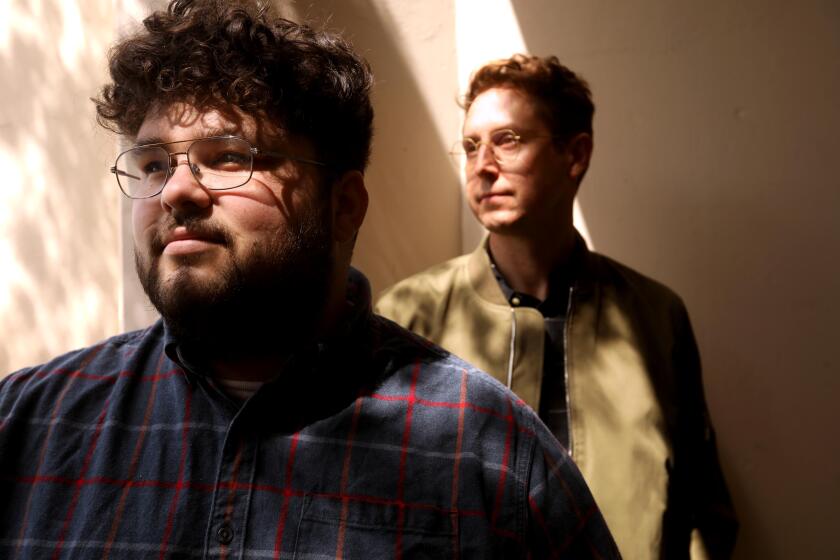Church Conversions
Nona and Richard Bogatch had been looking for a new home and place to open a business.
They spotted a for-sale sign on the former St. John’s Methodist Episcopal Church in downtown Ventura and immediately fell in love with the 113-year-old building’s stained-glass windows and 26-foot-high ceilings.
“We felt it was an answer to a prayer,” said Nona Bogatch.
The couple purchased the three-level building, which had also been used as a wedding chapel and photography studio, and spent the next two years fixing it up, eventually turning it into the Victorian Rose Bed & Breakfast on Main Street.
It is one of several old churches in Ventura County that have been transformed into something beyond their higher calling. Others are now being used as a business office, a performing arts venue and a private residence. In Simi Valley, an old church that became a mortuary is now a city-owned cultural arts center.
These conversions reflect a nationwide trend, in which communities and private investors are opting to save architecturally significant religious buildings instead of tearing them down after congregations downsize or move away.
Buyers are attracted to the acoustics, stature and ornate architecture of the structures. They also like the locations, which tend to be in the center of town along busy roadways.
“They have such presence, such dignity. They really make a statement on the street,” said Robert Jaeger, co-director of Partners for Sacred Places, a national organization based in Pittsburgh that helps communities and congregations preserve religious properties. “They have enormous cultural meaning. People are loath to let them go.”
Tod Tamberg, spokesman for the Archdiocese of Los Angeles, said Catholic officials believe churches automatically lose their holiness if they are destroyed or used solely for secular purposes. Church rules dictate that the buildings be sold for some kind of “dignified purpose,” determined on a case-by-case basis, he said.
“We would not sell a building to someone who is going to turn it into a night club, but we would sell it to someone who would turn it into a library,” Tamberg said. “There is a community value still there.”
There has been a growing awareness among towns to save their old churches, said Jo Allen Gause, author of “New Uses for Obsolete Buildings.”
Churches were often the focal point of the community--the place where people gathered to worship, wed and mourn their dead, she said. Local leaders are also recognizing these building as valuable remnants of the past that can’t be replicated with modern structures.
“They are the history that remind residents of how the city evolved,” said Gause, who also is a senior director at the Urban Land Institute, a research and educational association based in Washington, D.C. “It’s the city’s roots.”
That’s a big reason why Simi Valley decided to save the former Simi Community Methodist Episcopal Church at 3050 Los Angeles Ave.
Simi Valley Saves Landmark
Over the years, the 77-year-old church had been converted into a mortuary, residence and Jewish temple before it was boarded up. In 1995 a new owner was making plans to tear it down for redevelopment into a restaurant or office building.
But city leaders--wanting to preserve the local landmark--thought the site would be ideal for the cultural arts center they intended to build elsewhere for about $20 million. The city bought the church and spent $2.5 million on renovations, including a roof, electricity, plumbing and refurbished pews.
The 240-seat Simi Valley Cultural Arts Center now boasts two art galleries, a kitchen, dressing rooms and a multipurpose room. The former altar area is used as the main stage for plays, musicals and concerts. There’s also balcony seating where the church choir once sat.
City officials say the investment was worth it.
“You can keep on tearing down the old buildings and keep building modern structures, but I’m not sure that’s always the best way to go,” said Simi Valley Mayor Bill Davis. “You should be preserving some of the old for the people who come out here and [ask], ‘Geez, do you have anything that shows the history of Simi Valley?’ ”
Joe Murray, a Ventura painting contractor, was looking for an investment when he spotted an old Pentecostal church in Ventura. The altar area, the pews, the tall ceilings--everything about it--screamed “theater,” he said.
Murray and business partner Doug Halter, president of the Ventura Chamber Music Festival, renovated the 89-year-old church into the Laurel, a 200-seat theater for the performing arts at 1006 Main St.
Again the altar area became a stage, pews were refurbished, and the choir loft was turned into balcony seating. With the help of a $150,000 grant from the city, the bottom floor was renovated to accommodate tenants, which will soon include a photographer’s studio and offices for a chamber music organization.
There are certain advantages to working in an office with stained-glass windows.
“It makes me think of something very old, very in touch with spirituality,” said Elizabeth McIntyre, administrator of the Laurel.
“That’s what the performing arts is doing; it’s getting someone in touch with something bigger than sitting behind a desk at a computer.”
New Owners Find Spiritual Traces
Wendy Basil has a similar feeling. She and her business partner bought the Christian Science Church at 700 E. Main St. in Ventura nine months ago. They chose it for their marketing firm because of the stained-glass windows and the spaciousness of the 80-year-old structure.
They donated the pews, an organ and a podium to the private Santa Clara High School in Oxnard and then moved their offices into a downstairs reading room. They rented the upstairs sanctuary to a vacation-rental company and an adjacent suite of offices to an adoption agency.
“You feel the reverence that people had for the church,” said Basil, president of Halsted Communications. “This was a place that was well-tended, well cared for, and well-loved.”
Graphic designer Mick Haggerty said he always dreamed of living in a church. There was just something about the high walls and open space that appealed to him. When St. Francis of Assisi Church in Fillmore came on the market in the early 1990s, he bought the 85-year-old building.
He removed the pews, upgraded the plumbing and electricity, and converted the back offices into a kitchen and bathroom. He made the altar area into a place for eating and sleeping, and turned the choir balcony into a guest bedroom. He uses the bell tower as a retreat to stargaze by night and take in the panoramic mountain view by day.
Haggerty said he expected people to be puzzled when he first moved in.
But his area residents seem grateful that he put so much work into the building and then repaired it after the 1994 Northridge earthquake shattered windows, cracked plaster and damaged walls, he said.
Once, he bumped into a woman who explained how she had met her husband, celebrated their 50th wedding anniversary and mourned the loss of loved ones in the church. It was an encounter that made his decision even more worthwhile.
“I felt as though I was saving a building that would have been lost, and it was significant in people’s lives,” he said.
Church Is Now Bed-and-Breakfast
Nona and Richard Bogatch also live in their church turned bed-and-breakfast. They renovated the upstairs with five guest rooms--one in the choir loft, another below the loft, two in what had been Sunday school classrooms and one in what had been the pastor’s office.
They live in the basement, which they’ve fashioned into a small apartment with two bedrooms, a bathroom, an office, living room and kitchen.
Guests now gather in the former sanctuary, where the congregation once sat, to taste wine, cheese and homemade baked goods.
Despite the changes, the essence of the church has remained intact, Nona Bogatch said.
“A church can be anywhere. Our spirit is within us. Our body is the temple of God.”
More to Read
Start your day right
Sign up for Essential California for news, features and recommendations from the L.A. Times and beyond in your inbox six days a week.
You may occasionally receive promotional content from the Los Angeles Times.






